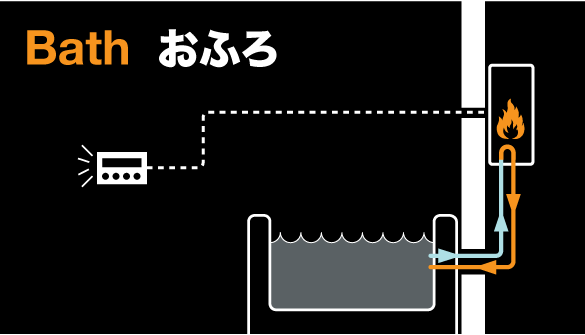A Culture of Bathing
In a land where hot water seems to bubble up from volcanic hot springs at every turn, it is little wonder that bathing is an integral part of Japanese society. When the country urbanized, the tall boiler chimneys of public bath houses (called sentos) popped-up throughout dense residential quarters of Japan’s towns and cities. Sentos offered a plentiful supply of piping hot water jetting from long banks of showers and overflowing from piping hot pools for communal luxuriating. These were also important social hubs where people from all walks meet, stripped bare of society’s trappings. As Japan became a leading technological and industrial exporter, household affluence grew and homes were built with their own baths. Today, local bathouses are a dieing institution, but the tradition lives on inside the the Japanese home – each equipped with its own miniature sento.
A Different Arrangement
Unlike typical Western bathrooms, in Japanese homes, toilet, sink, and bath & shower are in separate rooms. One disrobes in a changing room with a sink and then enters the waterproofed bathroom. Adjacent to the bath, a combined shower and faucet is installed at a low level against one wall (typically 40-50cm above the floor). The Japanese sit down on a small stool to shower. They tend not to run the water constantly. Instead, they get themselves wet, stop the water and wash themselves, then rinse with the shower head or by pouring hot water from the faucet over themselves with a small bucket or ladle. There is usually a mirror above the faucet for men to shave in.

Oidaki
Technology is at the heart of the Japanese bathroom. Speaking digital control panels in the bathroom and kitchen (or hallway) allow the user to set the hot water temperature and fill the bath remotely. A chirpy lady’s voice lets you know when the bath is almost ready and a little song chimes to let you know “it’s bath time!” Once drawn, bathwater may be kept for several days and shared by all family members. The bathwater is simply re-heated (a feature called “oidaki”) either via the controls or on a timer. This is why cleaning before entering the bath is gospel. There is no bigger cultural faux-pas for the visiting westerner than jumping straight into the bath without cleansing first. In Japan, the bath is for relaxing, not for cleaning. This seems to makes sense – why would you want to lie in your own dissolved filth!
With limited space, Japanese bathtubs tend to be small, squarer, and deeper than Western models which not only allows you to more deeply submerge your body, but also uses less water. Since it is filled remotely, there is no faucet to fill the the bath, just a simple outlet below the water line. The bath is concealed below an insulated cover when not in use.
Bath Units
Wetrooms seem to be a fairly recent Western craze, but having been long-established in Japan, the sophistication of products and technology are impressive. Most Japanese bathrooms are “unit-baths” – meaning the the entire bathroom (walls, floors, ceiling, bath, shower, drainage, and door) are sold as a single product. These prefabricated rooms are mostly made from molded plastic. Two manufacturers, Toto and Inax, dominate the market (although even Muji is in on the act) and offer an array of features. The latest must-have innovations are remote control via mobile phone and built-in TV. The oidaki re-heating feature requires a special type of boiler (either gas or electric models are available) that have supply and return lines to re-circulate the bathwater.
Proud Owner
In Japan, bathing is important bonding time between small children and their parents. You have all the freedom to splash around as water and steam is contained where they belong. As the proud owner of a Japanese bathroom, I have to say I find it far superior. I was never much of a bather when living in America and Britain, but now I appreciate always having a hot bath on-call. Our bathroom, changing room, and toilet are tiny, but the fact that they are separate is so much more practical. Obviously, no one pounds the bathroom door wishing to use the toilet or to do their make-up while you are soaking in the bath.
When designing our own home, we decided not to use the off-the-shelf unit-baths because they tend to feel sterile and cheap (with all that molded plastic it is is a bit like bathing in a large port-o-potty). We sourced the materials and equipment from separate suppliers and even added a hinoki (Japanese cypress) deck (sunoko) and bath surround. We really love the minimalist control panels from boiler manufacturer, Noritz (it seems so hard to find pure white plastic components in Japan). My favorite feature is intercom system between the bathroom and kitchen control panels (especially handy when ordering-up a beer from the fridge).
Despite all this sophistication, there still might be room for improvement. Most homes in Japan are still heated by inefficient fan-driven electrical AC units. I have yet to see a system that combines bath heating with whole-house heating (like radiators or underfloor). Also, with a digital system, it would be great to see energy uconsumption and even cost information via the display. I understand that the Japanese used to syphon bathwater into the washing machine, an idea that manufacturers have sadly failed to integrate.
